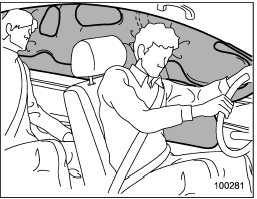Operation

The SRS side airbag and SRS curtain airbag can function only when the ignition switch is in the “ON” position.
The driver’s and front passenger’s SRS side airbags and SRS curtain airbags deploy independently of each other since each has its own impact sensor. Therefore, they may not both deploy in the same accident. Also, the SRS side airbag and SRS curtain airbag deploys independently of the driver’s and front passenger’s SRS frontal airbags in the steering wheel and instrument panel.
An impact sensor, which senses impact force, is located in each of the left and right center pillars and rear wheel houses.
Another impact sensor, which also senses impact force, is located under the rear center seat. In addition, a rollover sensor is located inside the airbag control module.
If one of the center pillar impact sensors and the impact sensor that is located under the rear center seat together sense an impact force above a predetermined level in a side collision, the control module causes both the SRS side airbag and curtain airbag on the impacted side to inflate regardless of whether the rear wheel house impact sensor on the same side senses an impact. If one of the rear wheel house impact sensors and the impact sensor that is located under the rear center seat together sense a sufficiently strong impact force, the control module causes only the SRS curtain airbag on the impacted side to inflate. If the rollover sensor detects rollover of the vehicle, the control module inflates the curtain airbags. After the deployment, the SRS side airbag immediately starts to deflate. The time required from detection of an impact to deflation of an SRS side airbag after deployment is shorter than the blink of an eye.
The SRS curtain airbags remain inflated for a while following deployment then slowly deflates.
The SRS side airbag and SRS curtain airbags deploy even when no one occupies the seat on the side on which an impact is applied.
When the SRS side airbag and SRS curtain airbags deploy, a sudden, fairly loud inflation noise will be heard and some smoke will be released. These occurrences are a normal result of the deployment.
This smoke does not indicate a fire in the vehicle.

Do not touch the SRS side airbag system components around the front seat seatback with bare hands right after deployment. Doing so can cause burns because the components can be very hot as a result of deployment.
After deployment, do not touch any part of the SRS curtain airbag system (from the front pillar to the part of the roof side over the rear seat). Doing so can cause burns because the components can be very hot as a result of deployment.
The SRS side airbag and SRS curtain airbags are designed to deploy in the event of an accident involving a moderate to severe side impact collision. Also, in the case of a rollover, the SRS curtain airbags deploy. They are basically not designed to deploy in a lesser side impact. Also, they are basically not designed to deploy in frontal or rear impacts because SRS side airbag and SRS curtain airbag deployment would not help the occupant in those situations.
Each SRS side airbag and SRS curtain airbags are designed to function on a onetime- only basis.
SRS side airbag and SRS curtain airbag deployment depend on the level of force experienced in the passenger compartment during a side impact collision. That level differs from one type of collision to another, and it may have no bearing on the visible damage done to the vehicle itself. Also, the SRS curtain airbags deploy depending on the vehicle’s position and inclination at the time of the rollover.
See also:
Warning and indicator lights
...
Door open warning light
When the ignition switch is in the “ON” position, the door open warning light
illuminates for approximately 2 seconds and then turns off.
The door open warning light illuminates if any door, the ...
Hill start assist warning light (MT models)
While the engine is rotating, if there are
any malfunctions in the Hill start assist
system, the light will illuminate.
When the Hill start assist warning
light illuminates, have the ve ...


